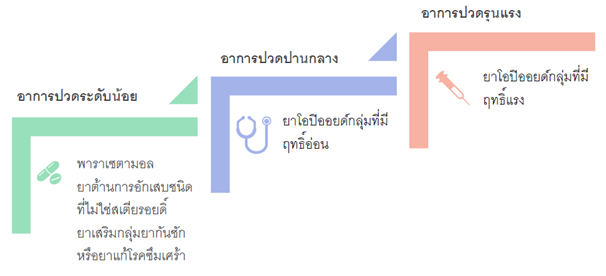Pain management in chronic kidney disease patients
Main Article Content
Abstract
Pain is one of common complaints in patients with chronic kidney disease, which if not properly managed, can lead to other adverse effects such as sleep disturbance, limitations in work and daily life, poor quality of life, and missed treatment session in dialysis-patients. Key factors in pain assessment include pain severity, chronicity of pain, nature of pain, and treatment goals. To achieve better treatment results, all of these factors should be evaluated and the appropriate medications can then be prescribed. Currently the main pain medications are paracetamol, non-steroidal anti-inflammatory drugs (NSAIDs) and opioids. All of which have altered pharmacokinetics and side effects are more common in patients with impaired renal function. Selection of drugs is recommended to consider all factors mentioned above. Paracetamol should be prescribed in people with mild pain. If symptoms do not improve or patients with moderate to severe pain then consider using non-steroidal anti-inflammatory drugs or opioids. This article describes how to evaluate pain and select appropriate drugs for pain control in patients with impaired kidney function.
Article Details

This work is licensed under a Creative Commons Attribution-NonCommercial-NoDerivatives 4.0 International License.
This article is published under CC BY-NC-ND 4.0 license, which allows for non-commercial reuse of the published paper as long as the published paper is fully attributed. Anyone can share (copy and redistribute) the material in any medium or format without having to ask permission from the author or the Nephrology Society of Thailand.
References
Davison SN, Koncicki H, Brennan F. Pain in chronic kidney disease: a scoping review. Semin Dial. 2014;27(2):188-204.
Cohen SD, Patel SS, Khetpal P, Peterson RA, Kimmel PL. Pain, sleep disturbance, and quality of life in patients with chronic kidney disease. Clin J Am Soc Nephrol. 2007;2(5):919-25.
Weisbord SD, Mor MK, Sevick MA, Shields AM, Rollman BL, Palevsky PM, et al. Associations of depressive symptoms and pain with dialysis adherence, health resource utilization, and mortality in patients receiving chronic hemodialysis. Clin J Am Soc Nephrol. 2014;9(9):1594-602.
Evans JM, Glazer A, Lum R, Heale E, MacKinnon M, Blake PG, et al. Implementing a Patient-Reported Outcome Measure for Hemodialysis Patients in Routine Clinical Care: Perspectives of Patients and Providers on ESAS-r:Renal. Clin J Am Soc Nephrol. 2020;15(9):1299-309.
Walker BJ, Polaner DM, Berde CB. Acute Pain. A Practice of Anesthesia for Infants and Children 2019. p. 1023-62.e15.
Lu E, Schell JO, Koncicki HM. Opioid Management in CKD. American Journal of Kidney Diseases. 2020.
Gosselin S, Juurlink DN, Kielstein JT, Ghannoum M, Lavergne V, Nolin TD, et al. Extracorporeal treatment for acetaminophen poisoning: recommendations from the EXTRIP workgroup. Clin Toxicol (Phila). 2014;52(8):856-67.
Martin U, Temple RM, Winney Rj, Prescott LF. The disposition of paracetamol and the accumulation of its glucuronide and sulphate conjugates during multiple dosing in patients with chronic renal failure. Eur J Clin Pharmacol. 1991;41:43-6.
Curhan GC, Knight EL, Rosner B, Hankinson SE, Stampfer MJ. Lifetime Nonnarcotic Analgesic Use and Decline in Renal Function in Women. Arch Intern Med. 2004;164(14):1519-24.
Kanchanasurakit S, Arsu A, Siriplabpla W, Duangjai A, Saokaew S. Acetaminophen use and risk of renal impairment: A systematic review and meta-analysis. Kidney Res Clin Pract. 2020;39(1):81-92.
Kantachuvesiri S, Kaojarern S, Kitayaporn D, Phanichphant S, Sumethkul V, Wananukul W, et al. Risk factors between analgesic use and chronic nephropathy in Thailand. The Southeast Asian journal of tropical medicine and public health. 1996;27(2):350-5.
Scarim C, de Oliveira Vizioli E, Santos J, Chung M. NSAIDs and Natural Products Interactions: Mechanism and Clinical Implications. J Immuno Clin Res. 2017;4(2):1040
Baker M, Perazella MA. NSAIDs in CKD: Are They Safe? Am J Kidney Dis. 2020;76(4):546-57.
Gooch K, Culleton BF, Manns BJ, Zhang J, Alfonso H, Tonelli M, et al. NSAID use and progression of chronic kidney disease. Am J Med. 2007;120(3):280 e1-7.
Nderitu P, Doos L, Jones PW, Davies SJ, Kadam UT. Non-steroidal anti-inflammatory drugs and chronic kidney disease progression: a systematic review. Fam Pract. 2013;30(3):247-55.
James A, Williams J. Basic Opioid Pharmacology - An Update. Br J Pain. 2020;14(2):115-21.
Trevor AJ, Katzung BG, Kruidering-Hall M. Katzung & Trevor's pharmacology : examination & board review. 2015.
Davison SN. Clinical Pharmacology Considerations in Pain Management in Patients with Advanced Kidney Failure. Clin J Am Soc Nephrol. 2019;14(6):917-31.
Sande TA, Laird BJ, Fallon MT. The use of opioids in cancer patients with renal impairment-a systematic review. Support Care Cancer. 2017;25(2):661-675.
Barakzoy AS, Moss AH. Efficacy of the world health organization analgesic ladder to treat pain in end-stage renal disease. J Am Soc Nephrol. 2006;17(11):3198-203.


